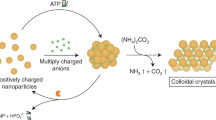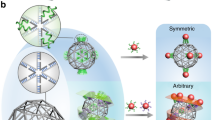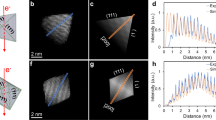Abstract
When organic molecules are tethered onto non-spherical nanoparticles, their chemical properties depend on the particles’ local curvature and shape. Based on this observation, we show here that it is possible to engineer chemical patchiness across the surface of a non-spherical nanoparticle using a single chemical species. In particular, when acidic ligands are used, regions of the particle surface with different curvature become charged at different pH values of the surrounding solution. This interplay between particle shape and local electrostatics allows for fine control over nanoscale self-assembly leading to structures with varying degrees of complexity. These structures range from particle cross-stacks to open-lattice crystals, the latter with pore sizes on the order of tens of nanometres, that is, at the lower synthetic limits of metallic mesoporous materials.
This is a preview of subscription content, access via your institution
Access options
Subscribe to this journal
Receive 12 print issues and online access
$259.00 per year
only $21.58 per issue
Buy this article
- Purchase on Springer Link
- Instant access to full article PDF
Prices may be subject to local taxes which are calculated during checkout





Similar content being viewed by others
References
Kassner, R. J. Effects of nonpolar environmens on redox potentials of heme compexes. Proc. Natl Acad. Sci. USA 69, 2263–2267 (1972).
Yoshizawa, M., Klosterman, J. K. & Fujita, M. Functional molecular flasks: new properties and reactions within discrete, self-assembled hosts. Angew. Chem. Int. Ed. 48, 3418–3438 (2009).
Zhang, X. Y. & Houk, K. N. Why enzymes are proficient catalysts: beyond the Pauling paradigm. Acc. Chem. Res. 38, 379–385 (2005).
Tezcan, F. A., Winkler, J. R. & Gray, H. B. Effects of ligation and folding on reduction potentials of heme proteins. J. Am. Chem. Soc. 120, 13383–13388 (1998).
Minten, I. J. et al. Catalytic capsids: the art of confinement. Chem. Sci. 2, 358–362 (2011).
Trembleau, L. & Rebek, J. Helical conformation of alkanes in a hydrophobic cavitand. Science 301, 1219–1220 (2003).
Iwasawa, T., Hooley, R. J. & Rebek, J. Jr. Stabilization of labile carbonyl addition intermediates by a synthetic receptor. Science 317, 493–496 (2007).
Fujita, D. et al. Protein encapsulation within synthetic molecular hosts. Nature Commun. 3, 1093 (2012).
Inokuma, Y. et al. X-ray analysis on the nanogram to microgram scale using porous complexes. Nature 495, 461–466 (2013).
Love, J. C., Estroff, L. A., Kriebel, J. K., Nuzzo, R. G. & Whitesides, G. M. Self-assembled monolayers of thiolates on metals as a form of nanotechnology. Chem. Rev. 105, 1103–1169 (2005).
Witt, D., Klajn, R., Barski, P. & Grzybowski, B. A. Applications properties and synthesis of omega-functionalized n-alkanethiols and disulfides—the building blocks of self-assembled monolayers. Curr. Org. Chem. 8, 1763–1797 (2004).
Miszta, K. et al. Hierarchical self-assembly of suspended branched colloidal nanocrystals into superlattice structures. Nature Mater. 10, 872–876 (2011).
Warren, S. C. et al. Ordered mesoporous materials from metal nanoparticle–block copolymer self-assembly. Science 320, 1748–1752 (2008).
Zhao, D. Y. et al. Triblock copolymer syntheses of mesoporous silica with periodic 50 to 300 angstrom pores. Science 279, 548–552 (1998).
Yang, P. D., Zhao, D. Y., Margolese, D. I., Chmelka, B. F. & Stucky, G. D. Generalized syntheses of large-pore mesoporous metal oxides with semicrystalline frameworks. Nature 396, 152–155 (1998).
Deng, H. et al. Large-pore apertures in a series of metal–organic frameworks. Science 336, 1018–1023 (2012).
Liu, K. et al. Step-growth polymerization of inorganic nanoparticles. Science 329, 197–200 (2010).
DeVries, G. A. et al. Divalent metal nanoparticles. Science 315, 358–361 (2007).
Glotzer, S. C. & Solomon, M. J. Anisotropy of building blocks and their assembly into complex structures. Nature Mater. 6, 557–562 (2007).
Laibinis, P. E. et al. Comparison of the structures and wetting properties of self-assembled monolayers of normal-alkanethiols on the coinage metal-surface, Cu, Ag, Au. J. Am. Chem. Soc. 113, 7152–7167 (1991).
Klajn, R., Stoddart, J. F. & Grzybowski, B. A. Nanoparticles functionalised with reversible molecular and supramolecular switches. Chem. Soc. Rev. 39, 2203–2237 (2010).
Browne, K. P. & Grzybowski, B. A. Controlling the properties of self-assembled monolayers by substrate curvature. Langmuir 27, 1246–1250 (2010).
Wang, D. W. et al. How and why nanoparticle's curvature regulates the apparent pKa of the coating ligands. J. Am. Chem. Soc. 133, 2192–2197 (2011).
Coskun, A. et al. Molecular–mechanical switching at the nanoparticle–solvent interface: practice and theory. J. Am. Chem. Soc. 132, 4310–4320 (2010).
Atkins, P. in Atkins’ Physical Chemistry 7th edn (Oxford Univ. Press, 2001).
Walker, D. A., Wilmer, C. E., Kowalczyk, B., Bishop, K. J. M. & Grzybowski, B. A. Precision assembly of oppositely and like-charged nanoobjects mediated by charge-induced dipole interactions. Nano Lett. 10, 2275–2280 (2010).
Gong, P., Wu, T., Genzer, J. & Szleifer, I. Behavior of surface-anchored poly(acrylic acid) brushes with grafting density gradients on solid substrates: 2. Theory. Macromolecules 40, 8765–8773 (2007).
Tagliazucchi, M., Calvo, E. J. & Szleifer, I. Molecular theory of chemically modified electrodes by redox polyelectrolytes under equilibrium conditions: comparison with experiment. J. Phys. Chem. C 112, 458–471 (2008).
Longo, G. S., Thompson, D. H. & Szleifer, I. Ligand–receptor interactions between surfaces: the role of binary polymer spacers. Langmuir 24, 10324–10333 (2008).
Nie, Z. H. et al. Self-assembly of metal–polymer analogues of amphiphilic triblock copolymers. Nature Mater. 6, 609–614 (2007).
Grzelczak, M. et al. Steric hindrance induces crosslike self-assembly of gold nano-dumbbells. Nano Lett. 12, 4380–4384 (2012).
Liu, M. Z. & Guyot-Sionnest, P. Mechanism of silver(I)-assisted growth of gold nanorods and bipyramids. J. Phys. Chem. B 109, 22192–22200 (2005).
Song, J. H., Kim, F., Kim, D. & Yang, P. D. Crystal overgrowth on gold nanorods: tuning the shape, facet, aspect ratio, and composition of the nanorods. Chem. Eur. J. 11, 910–916 (2005).
Santos, A., Singh, C. & Glotzer, S. C. Coarse-grained models of tethers for fast self-assembly simulations. Phys. Rev. E 81, 011113 (2010).
Kalb, J., Dukes, D., Kumar, S. K., Hoy, R. S. & Grest, G. S. End grafted polymer nanoparticles in a polymeric matrix: effect of coverage and curvature. Soft Matter 7, 1418–1425 (2011).
Hill, H. D., Millstone, J. E., Banholzer, M. J. & Mirkin, C. A. The role radius of curvature plays in thiolated oligonucleotide loading on gold nanoparticles. ACS Nano 3, 418–424 (2009).
Kou, X., Sun, Z., Yang, Z., Chen, H. & Wang, J. Curvature-directed assembly of gold nanocubes, nanobranches, and nanospheres. Langmuir 25, 1692–1698 (2009).
Walker, D. A., Kowalczyk, B., de la Cruz, M. O. & Grzybowski, B. A. Electrostatics at the nanoscale. Nanoscale 3, 1316–1344 (2011).
Walker, D. A., Browne, K. P., Kowalczyk, B. & Grzybowski, B. A. Self-assembly of nanotriangle super lattices facilitated by repulsive electrostatic interactions. Angew. Chem. Int. Ed. 49, 6760–6763 (2010).
Kalsin, A. M. et al. Electrostatic self-assembly of binary nanoparticle crystals with a diamond-like lattice. Science 312, 420–424 (2006).
Wilber, A. W. et al. Reversible self-assembly of patchy particles into monodisperse icosahedral clusters. J. Chem. Phys. 127, 085106 (2007).
Hahn, T. in International Tables for Crystallography, Volume A Space Group Symmetry 5th edn (Springer, 2005).
Ding, T., Song, K., Clays, K. & Tung, C. H. Fabrication of 3D photonic crystals of ellipsoids: convective self-assembly in magnetic field. Adv. Mater. 21, 1936–1940 (2009).
Lee, S. H. & Liddell, C. M. Anisotropic magnetic colloids: a strategy to form complex structures using nonspherical building blocks. Small 5, 1957–1962 (2009).
Demirors, A. F., Johnson, P. M., van Kats, C. M., van Blaaderen, A. & Imhof, A. Directed self-assembly of colloidal dumbbells with an electric field. Langmuir 26, 14466–14471 (2010).
Forster, J. D. et al. Assembly of optical-scale dumbbells into dense photonic crystals. ACS Nano 5, 6695–6700 (2011).
Acknowledgements
This work was supported by the Non-equilibrium Energy Research Center, which is an Energy Frontier Research Center funded by the US Department of Energy, Office of Science, Office of Basic Energy Sciences (award no. DE-SC0000989). D.A.W. acknowledges support provided by the National Science Foundation (NSF) MRSEC program (DMR-1121262) at Northwestern University and the Ryan Fellowship programme.
Author information
Authors and Affiliations
Contributions
D.A.W. and E.K.L. performed the experiments and analysis of the experimental results. R.J.N. and I.S. provided theoretical analysis of pKa data. D.A.W. performed theoretical analysis of interacting particles. D.A.W. and B.A.G. conceived the experiments and wrote the paper.
Corresponding author
Ethics declarations
Competing interests
The authors declare no competing financial interests.
Supplementary information
Supplementary information
Supplementary information (PDF 5355 kb)
Rights and permissions
About this article
Cite this article
Walker, D., Leitsch, E., Nap, R. et al. Geometric curvature controls the chemical patchiness and self-assembly of nanoparticles. Nature Nanotech 8, 676–681 (2013). https://doi.org/10.1038/nnano.2013.158
Received:
Accepted:
Published:
Issue Date:
DOI: https://doi.org/10.1038/nnano.2013.158
This article is cited by
-
Liquid-crystalline behavior on dumbbell-shaped colloids and the observation of chiral blue phases
Nature Communications (2022)
-
Assembly of planar chiral superlattices from achiral building blocks
Nature Communications (2022)
-
Self-regulated co-assembly of soft and hard nanoparticles
Nature Communications (2021)
-
Precisely Endowing Colloidal Particles with Silica Branches
Scientific Reports (2019)
-
Regioselective surface encoding of nanoparticles for programmable self-assembly
Nature Materials (2019)



